35. Dial up at distance
Extending reach is a fundamental purpose for firearms. One shooter who has made long reach a mission is John Burns, a Wyoming gun-builder who, with Coloradans Scott Downs and Don Ward, operate GreyBull Precision. They fashion hunting rifles for hunters who expect to shoot far. Chamberings: .243 and 7mm Remington Magnum.
Just two? “They’re all you need for western big game,” shrugs John. “We load 105- and 180-grain VLD bullets. We program our scopes so you can click to any yardage, even beyond 1,000 yards.” John and Scott have taken game at extreme range. “But that doesn’t mean we shoot irresponsibly,” John insists. “A hunter must know his limits and hew to them.” Maximum effective range depends on conditions that affect your precision. A close offhand shot can be tougher than a long poke with bipod or sling. Wind complicates a shot. So does your physical state; hitting gets hard when you’re catching your breath after a climb.
Targets also play a role, and not just as regards size. Shooting steel gongs and paper bulls-eyes at half a mile is great fun—and worthwhile practice! But even with a steady position and the best equipment, the risk of a crippling hit at such distances keeps me from shooting game that far. In fact, reaching a quarter mile with accuracy demands excellent marksmanship and favorable conditions.
Optics are a key component of GreyBull rifles. The firm contracts with Leupold to install its own reticle in Leupold’s 4.5-14x VX III sight. It’s essentially a Duplex with a few fine horizontal lines for range estimation, and one-minute tics to help you shade for wind. The elevation dial is meant to move; each is cut for a specific load and marked so you can quickly dial to the distance and hold center. Adjusting windage dials, most hunters agree, is bad business. Wind is always changing, and you can easily get lost dialing off zero. Numbers scribed atop distance marks on the elevation knob show minutes of lateral correction needed in a 10-mph crosswind. Testing these scopes, I’ve found yardage and windage marks accurate. Of course, a laser rangefinder is all but necessary to get the most from the elevation dial.

Offhand, John Burns draws a bead with a Leupold scope featuring his load-specific elevation dial.
“Calibrating a dial to match the arc of a bullet is a demanding job,” John concedes. “We have to know starting velocity and 700-yard drop to calculate the ballistic coefficient and accurately mark the dial.” GreyBull can supply scopes with dials for nearly any cartridge, provided that data is available. “Ballistic coefficients listed in catalogs aren’t always right,” John adds. “If that C number is off a little, you won’t notice it at under 400 yards. But the farther the bullet travels, the steeper its arc, and the more important the accuracy of the data.” John builds in third-minute clicks to replace standard quarter-minute detents. That’s so he can milk more distance from one dial revolution. “Then you won’t get a full-rotation error.”
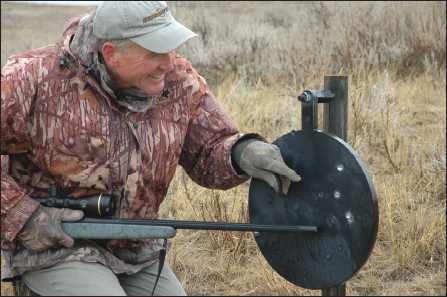
Wayne fired this group with a GreyBull rifle, prone, at 780 yards. Chambering: 7mm Rem. Mag.
Before you can benefit from a sight that tracks trajectory, you need ammo that delivers precision where arcs get steep. High-performance handloads help. John’s aren’t much if any faster than ambitious factory loads. However, VLD (very low drag) bullets retain velocity better than ordinary spitzers. That’s crucial at long range. You need the highest ballistic coefficient practical. In other words, the bullet must be heavy for its diameter (high sectional density) and sleek in form. Reducing rate of deceleration at distance matters a lot more than increasing muzzle velocity. A 180-grain 7mm bullet lies at the heavy end of the weight range; so too 105-grain .243s. These bullets, driven by Hodgdon’s Retumbo powder, shoot flat “and with enough precision for 1,000-yard hits,” says John. Because distance saps velocity, terminal behavior (upset and penetration) from hollow-point bullets can improve at long range—even as energy diminishes.
Long bullet ogives make seating a problem in short actions, so John prefers the roomy Remington 700 long actions, even for the .243. “Seating those 105-grain missiles out increases case capacity.” John cuts relatively long throats in his barrels, because “short bullet jump hasn’t produced the best accuracy for us. Besides, bullets seated into the rifling can become a problem in the field. One cartridge a tad long may stick the bullet when you close the bolt.” Instead, John guides bullets with a lengthy throat “the thickness of a fly’s wing” over bullet diameter. “Bullet alignment is crucial. Many factory chambers are too generous.”
GreyBull rifles wear 26 inch medium-heavy barrels from custom makers like Kreiger, Schneider and Lilja. John floats the barrel and glass-beds actions in a synthetic (hand laid) stock he and his partners designed. It has a steep, full grip and ample forend. A special stud accepts a Stoney Point flexible bipod.
Like me, John and his crew think stiff recoil and harsh muzzle blast can offset benefits afforded by accurate loads, costly barrels and sophisticated optics. “If you’re afraid of the rifle, you can’t shoot well,” he declares. A range session near our camp last fall confirmed that observation. I watched several hunters fire powerful rifles. Softball-size groups predominated—at 100 yards! One fellow had trouble hitting with his .338 Magnum. No wonder! At each pull of the trigger he shut his eyes and ducked away from the comb!
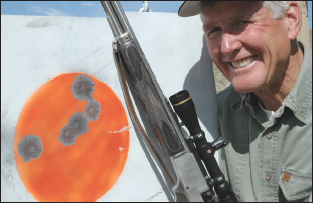
Prone, firing one shot each at 100, 200, 300, 400, 500, and 600 yards with his Marlin 1895, .338 Marlin Express, the Author used only the GreyBull dial on his Leupold to add elevation. All shots hit!
The GreyBull crew says mild recoil is one reason they like the .243 and 7mm Magnum. Both have accounted for deer and elk at extreme range.
“Nail that gong.” John handed me a GreyBull rifle in .243. Good grief! The 16 inch steel plate was so far it appeared a mere dot in the Wyoming sage. “It’s as big as a deer’s chest,” he said matter-of-factly. “Dial up to 800 yards. It’s actually 780, so take a click off.” I indexed the knob and settled onto the bipod. A sharp wind quartered toward us at roughly 15 mph. “Give it 4 minutes left windage.” At 780 steps, that’s 30 inches. Lots of air gaped between crosswire and plate!
Bang! The 2-lb Jewell trigger broke cleanly. “Add a minute left,” John advised. I did. Seconds after my next shot, we heard the distant pop of a solid hit. “We don’t advocate shooting at game half a mile off,” John emphasized. “But minute-of-angle precision at long range gives you great confidence at normal distances. It’s an ace in the hole if you must anchor an elk far away.”
Trusting the dial can be hard. “We loaned a rifle to a neighbor,” recalls John. “At 780 yards he hit high. I was perplexed until he admitted he held high. Of course, adding a few inches of elevation that way is absurd. Were it not for the dialed adjustment, he would still have planted his bullets several feet shy!”
More shooting at gongs, and a one-shot kill on a distant deer, convinced me the GreyBull system works. Hit on the shoulder, that buck and others killed by my camp-mates demonstrated the lethal effect of the VLDs. “Of course,” John reminded me, “aiming for the right spot is a requisite. You must also steady the rifle and break the shot without disturbing your sight picture.”
To see if the GreyBull scope would add reach to my lever-action Marlin in .338 Marlin Express, I had Don Ward cut an elevation dial for Hornady’s 200-grain FTX load. Installed on a 2 ½-8x36 Leupold, it didn’t look too much like a target knob. Mounted low, the scope complemented the 1895 Marlin nicely. But would it really benefit a lever gun? We tested it on the Wyoming prairie. After establishing a zero with a sling from prone, I bellied into the sage and fired one shot at a 10 inch steel gong from 100 yards. Then I moved back to 200, dialed up to “2” on the GreyBull knob and fired another shot. I repeated at 300, 400, 500 and 600 yards, one bullet at each range, trusting the dial and holding center. Every shot hit the 10 inch gong. Now, on a hunt, I limit my shooting to modest ranges. In fact, with that rifle I passed up my only shot of the season at a six-point elk. It was standing just 300 yards off, and I had a steady position. But the angle and the thick surrounding cover signaled caution. Almost surely I could have clobbered that bull; declining a shot, however, is never a bad choice.
Recently, I put GreyBull hardware to the test on a hunt. The scope wore a dial carefully scribed to match the arc of a 129-grain SST bullet in Hornady’s then-new 6.5 Creedmoor. The cartridge derived from Dave Emary’s discussions with 1,000-yard shooters, who favored a mild 6.5. An accomplished marksman himself, Emary distilled the requisites: high ballistic coefficient, low recoil and easy adaption to short-action bolt rifles. Dave revamped the compact .30 T/C hull (also from Hornady), whose neck would keep long, pointed bullets within the limits imposed by short magazines. He used powder technology from the firm’s Superformance Ammunition to get eye-popping speed from 129-grain SSTs. The Creedmoor starts on the heels of 130-grain .270 loads. Beyond 400 yards, its superior ballistic coefficient narrows the gap, then erases it. “It’s a great round,” Dave enthused, after he’d shot a couple of bucks far away. “It’s easy to shoot but deadly on deer. And we’ve punched half-minute groups with a T/C Icon!”
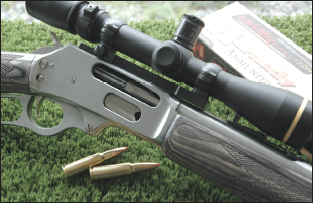
This Marlin 1895 in .338 Marlin Express wears a Leupold scope with GreyBull dial for distance.
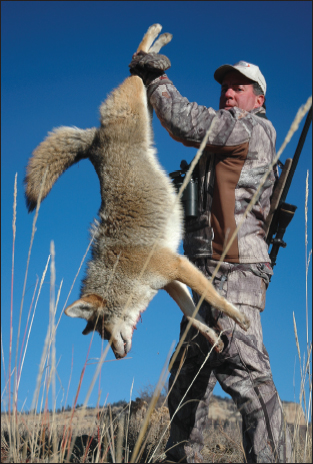
John Burns hoists a coyote that came to his call and fell to Wayne’s 6.5 Creedmoor at 250 yards.
I ordered a Ruger Hawkeye in 6.5 Creedmoor. But hunting season arrived before I had a chance to scope it. Then Todd Seyfert at Magnum Research delivered a test rifle barreled to the Creedmoor on a long 700 action. Magnum Research rifles have impressed me in the past—a trim .280 killed a pronghorn at 393 steps— so this 6.5 got my quick attention. Its long carbon-fiber barrel had a stainless core rifled by Kreiger. GreyBull Precision provided the stock and the 4.5-14x Leupold. Prone, with a sling, I was soon zeroed at 200 yards. After a spin of the dial and a shading for wind, every bullet rang iron at 500 yards.
A few days later, on a frosty morning with no wind, I managed to miss a New Mexico coyote from the sit at 200 yards. “Yanked the trigger,” I admitted. Fate was kind, however. John and Phil called expertly at a second spot to coax another hungry coyote across a sunny mesa. As the dog skidded to a halt 250 yards off, I began a measured crush, again from the sit. The coyote slumped without a twitch.

This elk fell to a single 129-grain Hornady bullet from a 6.5 Creedmoor at very long range.
Alas, the elk that year were proving more elusive. After John and Phil and I joined Ray Milligan near Chama, we saw plenty of animals; but the season was already weeks along, and branch-antlered bulls had felt the pressure.
Then, one evening on the hem of a huge sage basin, we got a break. Scant minutes of legal light remained. The elk sifted through the purple shadows half a mile distant. They were moving away.
“We can get closer.” Ray Milligan tried to inject optimism. He’d had plenty of practice. Milligan Brand Outfitting hosts many elk hunters in northern New Mexico each year. Dozens go home with bulls.
“Let’s do it fast,” I hissed, picking up the pace.
Phil, John and Ray stayed close on my heels through the pinions. We scooted up the spine until it fell off abruptly, the sage a sea below us, the elk edging toward a ridge on its far shore.
“Six hundred.” Ray’s Leica Geovid binocular confirmed John’s read.
“Too far.” I shook my head, gulping wind.
“Get ready.” Ray urged. Roger that. This five-point might be our only chance. Whatever the range, you make final decisions after you’re ready to fire, not before.
Sliding the sling up my arm, I flopped prone and chambered a round, then spun the elevation dial to 6. Dead-still air promised zero drift. Confident in the Magnum Research rifle after its stellar performance on distant steel, I was equally sure GreyBull’s dial had accurately corrected for the bullet’s steepening arc. Still, I hesitated. This elk was twice as far as any elk I had shot at in 35 years of hunting. I had passed shots at many closer bulls, one just this morning. The smallest errors in hold and execution become problems at extended range. What if the bullet strayed? A follow-up shot would be almost impossible if the elk moved. Certainly they would. And trailing a hit animal would be difficult at best. I didn’t have to shoot this elk….
Still, my position was solid, the air dead-calm. I felt my excuses slipping away.
“Trust the dial,” John whispered. “Remember, you kept all the bullets in a 12 inch gong at 500.”

Wayne tests a Burris Eliminator range-compensation scope on a SIGSauer SSG 3000 in .308.
The raghorn bull was quartering to, almost entirely exposed. Not yet. My finger came taut against the trigger. The crosswire quivered in the shoulder crease. The bull turned slightly.
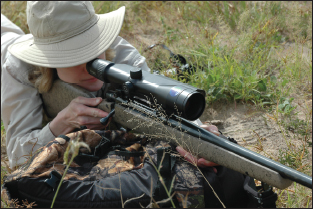
Laser-ranging scopes, like this one from Zeiss, make hitting at long range easier: If you’re steady.
Still uncommitted, I saw him stop, tawny ribs golden in the orange, slanting light of dusk. Of such moments are memories made.
Table of contents
- Title Page
- Dedication
- Copyright
- Acknowledgments
- Foreword
- CONTENTS
- INTRODUCTION
- SECTION I: BALLISTICS IN HISTORY
- SECTION II: THE MUSCLE BEHIND THE SHOT
- SECTION III: BULLETS—THE INSIDE STORY
- SECTION IV: SPEED, ENERGY, AND ARC
- SECTION V : PUTTING BALLISTICS TO WORK
- SECTION VI: FOR LONGER REACH
- BALLISTICS TABLES FOR MODERN SPORTING RIFLES
- GLOSSARY